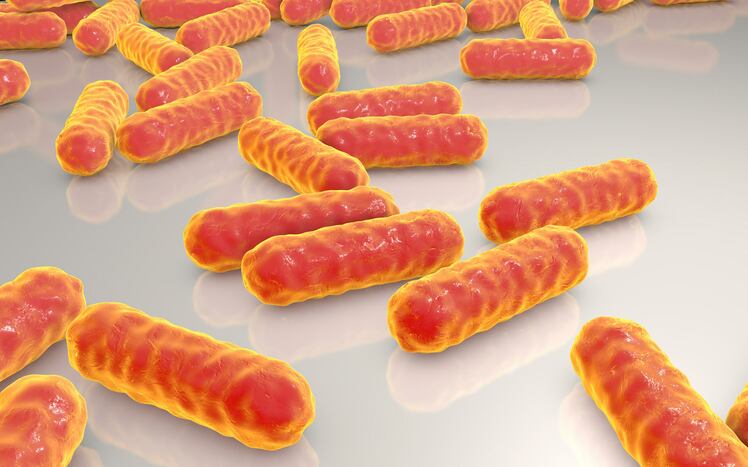CDI is an intestinal infection often acquired when antibiotics have wiped out the good bacteria in the gut. The role of Western and weight-loss diets in the risk of progression of this infection is poorly understood.
Therefore, researchers from the University of Nevada, Las Vegas (UNLV), carried out a longitudinal study in which they found that popular high-fat/high-protein weight-loss diets enhanced CDI risk during antibiotic treatment in mice.
The two high-fat diets exacerbated CDI, with a high-fat/high-protein, Atkins-like diet leading to severe CDI and 100% mortality and a high-fat/low-protein, medium-chain-triglyceride (MCT)-like diet inducing highly variable CDI outcomes. The authors hypothesise this may be due to the synergistic effects of a loss of the microorganisms that normally inhibit C. difficile overgrowth and an abundance of amino acids that promote overgrowth.
They also found that mice fed a high-carb diet were protected against symptoms of CDI despite the fact the inulin content of the high-carb diet was low. Instead, the major sources of carbohydrates were corn starch (43.5%), maltodextrin (14.4%), and sucrose (11.0%). Since these carbs would not be expected to improve gut health, the authors of this study hypothesise that the apparent protective effect of this diet may be due to the low protein and/or fat content rather than to protective effects of carbohydrates.
"Every day, we are learning more about the human microbiome and its importance in human health," said Brian Hedlund, a UNLV microbiologist and study co-author. "The gut microbiome is strongly affected by diet, but the C. diff research community hasn't come to a consensus yet on the effects of diet on its risk or severity. Our study helps address this by testing several diets with very different macronutrient content. That is, the balance of dietary carbohydrate, protein, and fat were very different."
Study
Groups of five mice were fed diets differing in macronutrient composition: a high-fat/high-protein diet, a high-fat/low-protein diet, a high-carbohydrate diet, and a standard laboratory diet.
Morbidity and mortality were examined over the course of the experiment.
Those fed the lab diet developed mild CDI signs but eventually recovered. The mean time of CDI sign onset was 2.8 ± 0.4 days, and the mean recovery time was 4.8 ± 0.4 days.
In contrast, only two of the mice fed the high-carb diet exhibited mild symptoms, and they quickly recovered. The mean time of CDI sign onset was 2.0 ± 1.8 days, and the mean recovery time was 3.0 ± 1.3 days. The rest of the animals in this group never developed any CDI signs.
Mice fed the high-fat/low-protein diet showed CDI symptom onset heterogeneity. Two animals developed severe CDI and became moribund. Meanwhile, three animals developed mild to moderate CDI signs similar to those seen with the standard diet and recovered within a week postinfection. The mean time of CDI sign onset was 3.2 ± 0.4 days, and the mean recovery time was 6.0 ± 0.0 days.
All mice fed the high-fat/high-protein diet developed severe CDI signs and were euthanized within four days following C. difficile challenge. For these mice, the mean time of CDI sign onset was 1.6 ± 0.5 days.
There were significant differences in richness, evenness, and Shannon diversity between the diet groups after mice were fed the experimental diets for 10 days (day 13). For mice fed the standard and high-fat/low-protein diets, most alpha diversity metrics returned to their diet-acclimated states within 30 days post-challenge.
In contrast, gut microbiome richness did not return to normal in mice fed the high-carbohydrate diet over this time.
New questions raised
Hedlund and study co-author Ernesto Abel-Santos, a UNLV biochemist, caution that the study was conducted using an animal model, and more work is underway to begin to establish a link between these diets and infections in people.
Recent studies suggest that because antibiotics kill bacterial species indiscriminately, the medications decimate populations of organisms that compete for amino acids, leaving C. diff free to propagate.
But Hedlund said the story is even more complex. The new work suggests that diet may promote microbial groups that can be protective, even after antibiotics. For an infection to flourish, he said, "you might need this combination of wiping out C. diff competitors with antibiotics and then a diet that promotes overgrowth and disease."
Hedlund adds that the study raises other questions as well as the high-carb diet, which was protective against C. diff infection, gave rise to the least diverse community of microbes.
"Lots of papers say that a lower microbial diversity is always a bad thing, but in this case, it had the best disease outcome," said Abel-Santos. However, he cautions that a high-carb diet could lead to animals becoming asymptomatic carriers that can disseminate the infection to susceptible subjects.
Source: mSystems
Hedlund. B. P., et al
"A High-Fat/High-Protein, Atkins-Type Diet Exacerbates Clostridioides (Clostridium) difficile Infection in Mice, whereas a High-Carbohydrate Diet Protects"
DOI: 10.1128/mSystems.00765-19


